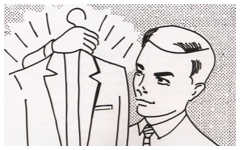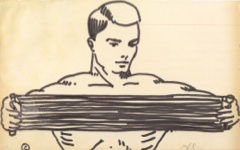Lichtenstein’s Girl with an Accordion (1961)

Lichtenstein, Girl with Accordion (1961) Pochoir, brush, pen and india ink. The Sonnabend Collection.
Click image to enlarge.
This early drawing by Lichtenstein of a girl playing the accordion shares elements beyond music with another of his 1961 drawings, Piano. (See its own entry.) The re-appearance of these motifs here, most never seen before, help confirm them. They are also, surprisingly perhaps, part of a tradition begun in the Renaissance in which the playing of a musical instrument (often by an angel) is related to art-making. [See, as examples, Carpaccio's Presentation of Jesus in the Temple (1510) and Caravaggio's Rest on the Flight into Egypt (c.1597).]
Click next thumbnail to continue

Detail of Lichtenstein's Girl with Accordion (1961) with a photograph of the artist, horizontally flipped, inset.
Click image to enlarge.
Just as Lichtenstein's boyish Man with a Chest Expander (c.1961) bears a slight but intentional resemblance to the artist, so does the girl here. Her eyebrow rising up to the right is a defining characteristic of the artist's face though, as his reflection, his arched eyebrow is on the other side. (The photo at left has been horizontally flipped for comparison.) Both the man, somewhat feminine, and the girl convey the androgyny of the artist's mind, a pure mind and a fully human one.
Click next thumbnail to continue

Top L: Lichtenstein, Girl with Accordion (1961)
Top R: Lichtenstein, Piano (c.1961)
Bottom L: Diagram of Girl with Accordion
Bottom L: Diagram of Piano
,
Click image to enlarge.
The accordion, like the bands of the chest expander, is made up of lines, the basic element of drawing so, metaphorically speaking, the girl playing the accordion is playing with lines. The shading on the bellows, as we saw on the Piano (near left, top and bottom), is shaped like an eye to indicate both that the scene is behind the artist's eye, not in front, and that music is a metaphor for a visual art, not an aural one.
In addition, the black pupil of the accordion's "eye" has a slight extension to it morphing the pupil into the shape of a crochet, the basic musical note. A "crochet" can also be seen in the shading on the lid of (the) Piano.
Click next thumbnail to continue
Rotate the image a quarter-turn (as at left) and the band of the accordion takes on the shape of an eyelid with a hand emerging through it. Cleverly, the hand plays the bass buttons as though it is turning them into his famous Ben-day dots.1 The combination of a hand symbolizing craft and an eye visual perception is another old tradition. Modern painter-poets cannot have missed such symbolism in earlier art. You can see it in museums everywhere. For the more-than-90 examples on this site, explore the theme, Hand and Eye.
Click next thumbnail to continue

Detail (L) of Lichtenstein's Girl with Accordion with enlarged detail (R) of sleeve.
Click image to enlarge.
The small changes Lichtenstein made to his source images may be small, as he once said, but they are crucial. Here the gathered sleeve of the musician's dress (detail at right) forms a regal crown at a jaunty angle. He may not have included the 3 letters of his first name (ROY), as he did in other images analyzed here, but included a royal crown instead.2 As explained in Alka-Seltzer (1966) this not only refers to the regal etymology of his name but the alchemical symbolism of a king as well: the human mind at its most pure when it is also most creative.
More Works by Lichtenstein
Notes:
1. Isabelle Dervaux noted a playful allusion between the dots and the bass buttons in this drawing in Roy Lichtenstein: The Black-and-White Drawings, 1961-1968 (New York: The Morgan Library) 2011, p. 94.
2. For the inclusion of Lichtenstein's first name, see also Untitled (Man with a Chest Expander).
Original Publication Date on EPPH: 23 Jan 2013. | Updated: 0. © Simon Abrahams. Articles on this site are the copyright of Simon Abrahams. To use copyrighted material in print or other media for purposes beyond 'fair use', you must obtain permission from the copyright owner. Websites may link to this page without permission (please do) but may not reproduce the material on their own site without crediting Simon Abrahams and EPPH.




